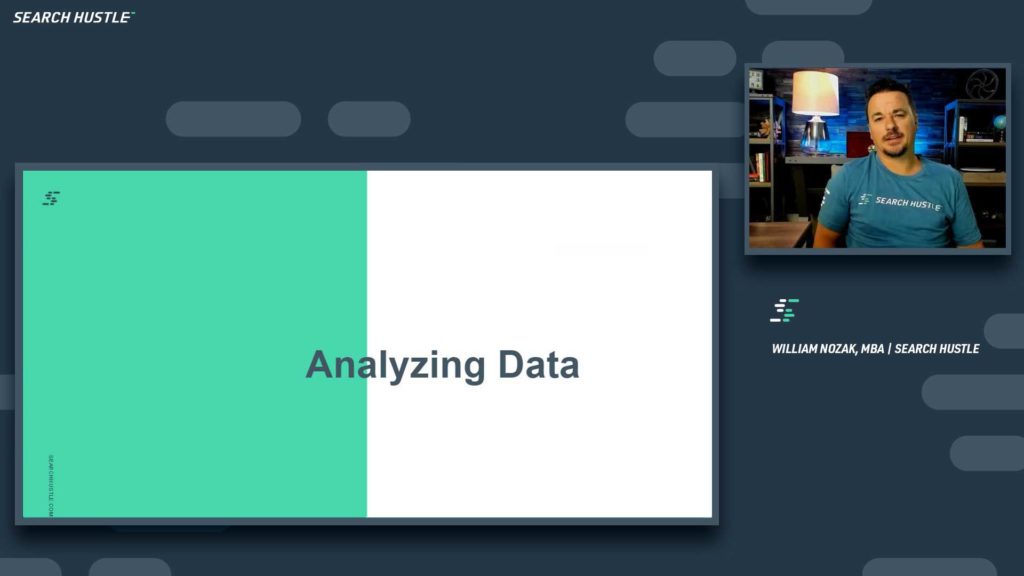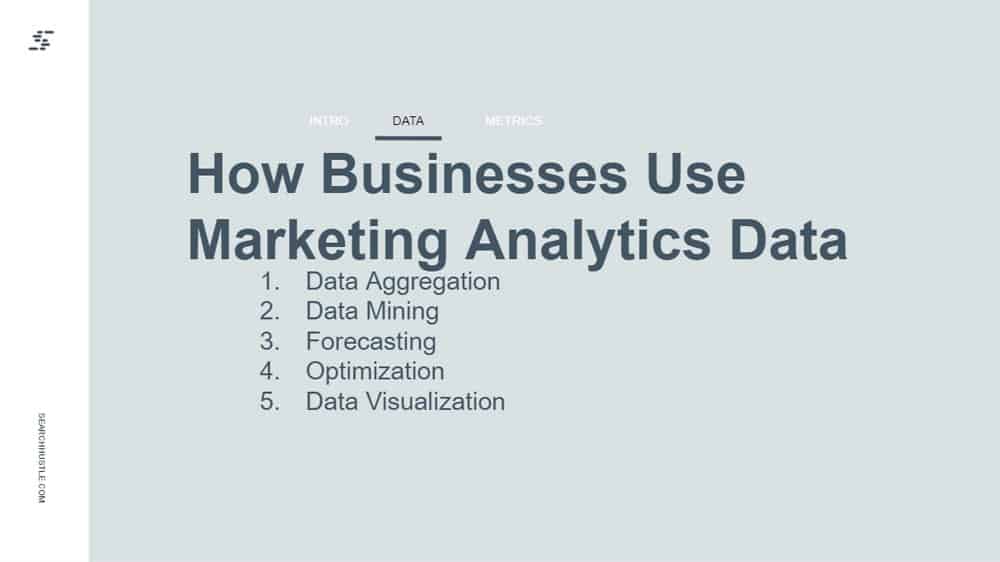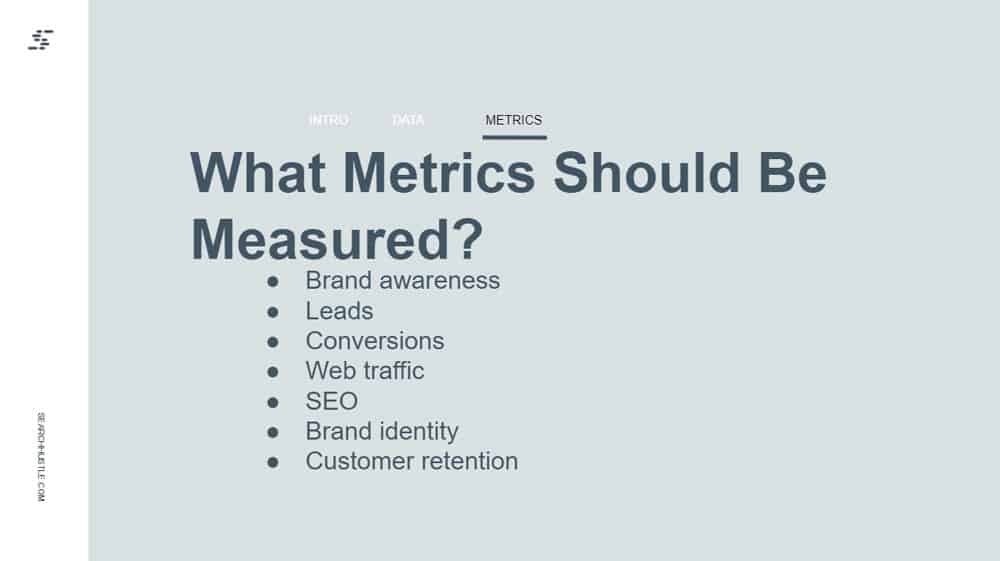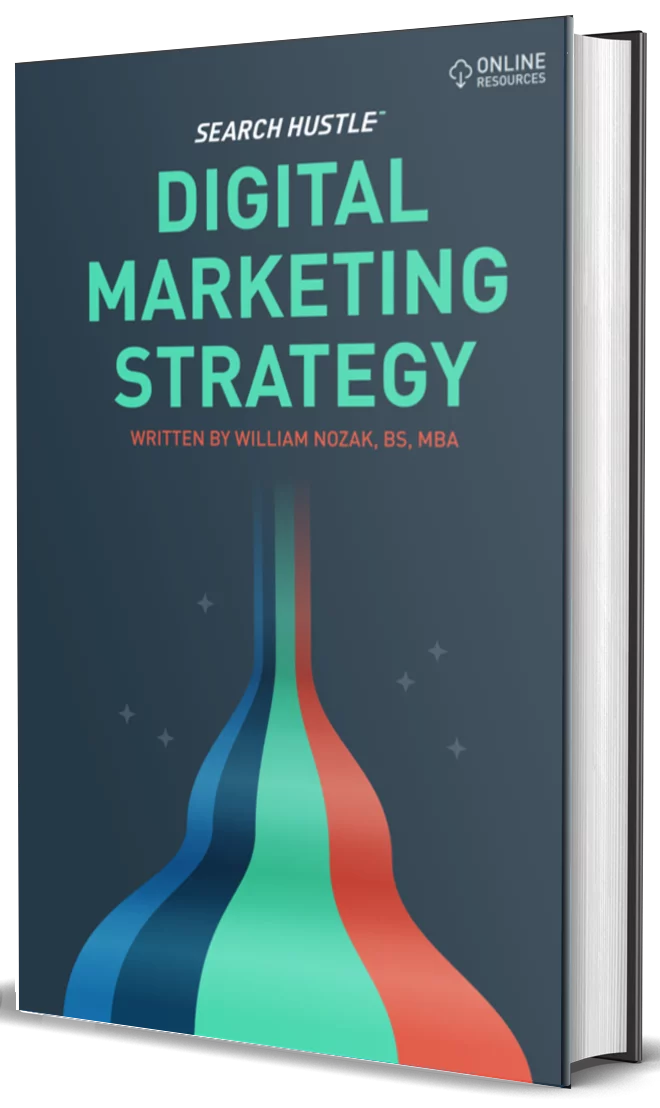Analyzing Data

Stay ahead of the competition by employing analytics to uncover patterns and relevant data to optimize campaigns. Analyzing data helps a business earn a higher ROI on its marketing decisions and much, much more. Analytics benefits consumers too. It ensures they see more targeted ads that are personalized and relevant to their needs and interests.
Studies have shown that businesses using five or more marketing analytics tools are 39% more likely to see improvement in marketing campaign performance. It’s important to use different tools to gather comprehensive and granular data. In turn, businesses can more accurately gain insight from the data on which to base their decisions.
How Businesses Use Data
Marketing data helps businesses decide how to optimize campaigns, forecast new market trends, and more. Drawing data from multiple sources is imperative to achieve an extensive view. When using marketing data, a business is able to:

Data Aggregation
A process of bringing information together and delivering it as a summary.
To get a complete picture, aggregate data from every marketing campaign so that all campaigns can be compared against each other. In turn, all information should be translated into one primary data aggregation – showing how products perform across different channels, demographics, etc.
Digital marketing professionals often use data aggregation in areas such as key performance indicators (KPIs), budget allocation, product development, and more.
Data mining
The process of analyzing large batches of data and discerning patterns within it. Data mining can form a comprehensive view of consumers and their behavior. With this information, you can exploit new market opportunities.
Data mining lets you learn about customers’ purchasing histories, preferences, demographics, and more. For example, a company could use data mining to create a list of products with the highest sales. Then, they can develop targeted ads with relevant product suggestions using analytics.
Data mining is also useful to help influence consumers in real time. Let’s use Amazon as an example. When a customer purchases a product, Amazon makes product recommendations based on what other customers have purchased in addition to that specific product.
Forecasting
Predictive analytics uses historical data to inform trends that your business can anticipate in the future.
These days, consumers have more choices than ever. They’re no longer limited to whatever can be found at the local store. Instead, they can order what they want when they want, and they get a choice of who to order it from. This leads to fierce competition between companies. Remaining competitive means a business must be able to predict consumer trends and take action.
This is where predictive analytics comes in. With the right information, you can understand consumer trends, predict future shifts, and plan accordingly. Through this process, forecasts around types of products and advertisements help drive and increase sales.
Optimization
The real value of data is in the insights it provides to business leaders and how it helps optimize their marketing strategy.
Just 17% of marketers use A/B tests on landing pages to improve conversion rates. To create an informed A/B test, you must use data to optimize two landing pages. Further optimization occurs by testing the two pages and ultimately prioritizing the landing page that best converts.
Savvy leaders use optimization as part of their marketing strategy as it helps identify weaknesses and guides improvements. This helps keep a business ahead of the curve and prevents it from becoming less relevant.
For example, consider the perks of technical optimization. According to Google, the bounce rate for pages increases when load time goes from 1 to 10 seconds. A business could take this knowledge and optimize all pages for faster load times to reduce bounce rates.
Data Visualization
Businesses can use data to create visualizations. Data visualization uses the information to create visual elements that tell a story. This helps make data more meaningful, accessible, and engaging.
You can use various types of data visualizations, such as infographics, charts, and diagrams.
When using data visualization, remember to keep one core objective to communicate and then add context that’s related to that objective.
This prevents visualizations from becoming cluttered and confusing. Additionally, context ensures the data visualization has clarity and that the reader can understand it and derive value from it. Effective visualizations should not require additional explanation for the reader to understand what is conveyed.

What Metrics Should I Be Measuring?
Build brand awareness
Brand awareness is how familiar a target audience is with a brand. A brand that has high brand awareness is often referred to as “trendy” or “popular.”When a consumer feels a connection to a brand, they are more likely to become a repeat customer. In essence, brand awareness efforts help humanize a brand and give it personality.
Brand awareness is also important for the continued success of a business because it builds brand equity. A brand’s value is what is known as brand equity.When a brand is in high demand and has an overall positive perception from consumers, then a business can have:
- Higher prices on products because of a higher perceived value
- Larger social impact
- Higher stock price
Brand awareness is the building block to having brand equity.
Generate leads
Lead generation is the process of capturing a consumer’s interest in a product or service with the intent of having their journey down the sales funnel. Incorporating lead generation can help build brand awareness, generate qualified leads, and help close deals.
It’s essential for a business to monitor lead generation so that it knows if its budget is being put to good use. As data is gathered, businesses can gain a deeper insight into the customer journey.
Increase conversions
Conversions can have different definitions based on what the business is wanting to measure. In a broad sense, conversions can be interpreted as any meaningful interaction with a product, such as how many views a product page gained. However, in most cases, businesses are concerned with the type of conversions that deal with verified sales.
When a business tracks conversions, it can help with making smarter marketing decisions. A business can identify what keywords work best to generate conversions, which then informs the business where to focus efforts for future campaigns.
Increase web traffic
Increasing web traffic is a vital part of running a business with a site. When there’s a steady flow of visitors to the site of a business, then marketing funnels get prospects, and sales naturally grow.
Marketing analytics can help analyze a website and tell a business how users navigate it. This analysis can then help a business develop strategies for its site that will better attract more people.
If a business wants to track its web traffic, then it should monitor things like referrals, keywords, and its most visited pages.
Improve SEO
When it comes to search engine optimization (SEO), measurement is the key to success. By using marketing analytics, a business can find out who its audience is, what they’re searching for, how they found the website, how long they’re staying on the site, and much more.
There are numerous benefits to monitoring the SEO performance of a business.
For one, it can provide data on how to improve the navigation structure of the website. The website’s navigation matters because it affects factors like how long people stay on the website, whether they visit different pages, etc. The easier a navigation structure is, the more effective it is at directing leads through the sales funnel.
Next, marketing analytics can inform what organic search queries a business is currently ranking high for and then build content around that. If the website has a search bar, data analytics can reveal what people are inputting into the search bar to find on the website.
Beyond that, SEO can be improved through marketing analytics by learning what site page needs its loading speed improved, what high-performing blog posts can be converted into lead magnets, and much more.
Establish brand identity
Considering there are billions of businesses out there, it’s crucial for a business to have a strong brand identity to help it stand out amidst the competitors. Brand identity consists of what a brand says, what its values are, how it advertises its products, and what it wants people to feel when interacting with it. At its core, the personality of the business is the brand identity.
Once a business has a strong brand identity, it can use this to attract new customers. Once these people become customers, brand identity helps to boost brand loyalty. When a business monitors brand identity, it is keeping an eye on how people talk about and interact with the brand. This then enables the business to make changes to the brand when needed.
Data Must Be Analyzed To Be Valuable
Marketing analytics can help a business improve in multiple areas. Collecting data is meaningless without analyzing it to gain actionable insight. Once a business learns how to effectively employ marketing analytics, it will be able to discover how to more efficiently reach key objectives.

Ready to Take Your Search Hustle Further?



